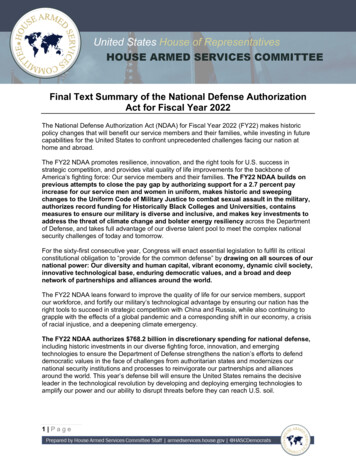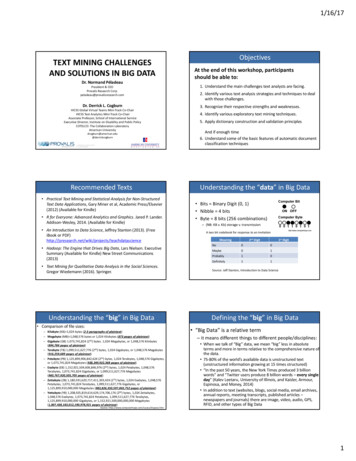
Transcription
Final Text Summary of the National Defense AuthorizationAct for Fiscal Year 2022The National Defense Authorization Act (NDAA) for Fiscal Year 2022 (FY22) makes historicpolicy changes that will benefit our service members and their families, while investing in futurecapabilities for the United States to confront unprecedented challenges facing our nation athome and abroad.The FY22 NDAA promotes resilience, innovation, and the right tools for U.S. success instrategic competition, and provides vital quality of life improvements for the backbone ofAmerica’s fighting force: Our service members and their families. The FY22 NDAA builds onprevious attempts to close the pay gap by authorizing support for a 2.7 percent payincrease for our service men and women in uniform, makes historic and sweepingchanges to the Uniform Code of Military Justice to combat sexual assault in the military,authorizes record funding for Historically Black Colleges and Universities, containsmeasures to ensure our military is diverse and inclusive, and makes key investments toaddress the threat of climate change and bolster energy resiliency across the Departmentof Defense, and takes full advantage of our diverse talent pool to meet the complex nationalsecurity challenges of today and tomorrow.For the sixty-first consecutive year, Congress will enact essential legislation to fulfill its criticalconstitutional obligation to “provide for the common defense” by drawing on all sources of ournational power: Our diversity and human capital, vibrant economy, dynamic civil society,innovative technological base, enduring democratic values, and a broad and deepnetwork of partnerships and alliances around the world.The FY22 NDAA leans forward to improve the quality of life for our service members, supportour workforce, and fortify our military’s technological advantage by ensuring our nation has theright tools to succeed in strategic competition with China and Russia, while also continuing tograpple with the effects of a global pandemic and a corresponding shift in our economy, a crisisof racial injustice, and a deepening climate emergency.The FY22 NDAA authorizes 768.2 billion in discretionary spending for national defense,including historic investments in our diverse fighting force, innovation, and emergingtechnologies to ensure the Department of Defense strengthens the nation’s efforts to defenddemocratic values in the face of challenges from authoritarian states and modernizes ournational security institutions and processes to reinvigorate our partnerships and alliancesaround the world. This year’s defense bill will ensure the United States remains the decisiveleader in the technological revolution by developing and deploying emerging technologies toamplify our power and our ability to disrupt threats before they can reach U.S. soil.1 Page
TABLE 1: FY22 NDAA Funding Levels*Budget ItemDoD Discretionary BaseDoE Discretionary BaseDefense-Related Activities*FY22 Discretionary Topline**Amount (in billions of dollars) 740.0 27.8 0.4 768.2*Does not include 9.8 billion in national defense authorizations outside of HASC jurisdictionand other adjustments**Does not include mandatory defense spendingSummary of Provisions in the FY22 NDAAMILITARY PERSONNELDiversity and Inclusion Requires independent review from the Services on the recruitment and retention ofHispanic service members. Updates outdated diversity training requirements to ensure training includesprogramming to reduce discrimination and bias based on race, gender, age, religion,sexual orientation, and gender identity, among other items. Requires briefing on efforts related to recognize the Service of African Americans whohave served in the Armed Forces as it relates to naming conventions of militaryinstallations, infrastructure, vessels, and weapon systems.Countering Extremism Requires DoD to submit a report on including a criminal article in the Uniform Code ofMilitary Justice (UCMJ) to address violent extremism Directs the Secretary of Defense to provide a briefing on all studies regarding efforts ofextremist organizations to recruit members of the armed forces, and a strategy todevelop and implement training to prevent such recruitment efforts.Private Funding of National Guard Activities Prohibits private funds from being used to fund any State's National Guard deploymentin another state, except for natural disaster emergencies.2 Page
Uniform Code of Military Justice (UCMJ) ReformsSpecial Trial Counsel Removes the Commander from decisions related to the prosecution of covered crimesincluding rape, sexual assault, murder, manslaughter, and kidnapping. Creates an Office of the Special Trial Counsel within each Service and ensuring theirindependence by requiring they directly report to the Service Secretary. The provisionalso defines the role and responsibilities of these prosecutors and including theirrequired experience. Criminalizes sexual harassment under the Uniform Code of Military Justice. All claims ofsexual harassment will be required to be investigated by an independent investigatoroutside the chain of command. Establishes judge-alone sentencing and sentencing parameters to increase fairnessacross the system. Increases the notification for Survivors of Sexual Assault by directing the Services tonotify survivors of sexual assault about the outcomes of any administrative action takenagainst their perpetrator.Sexual Assault Response and Prevention Requires a study on including a military occupational specialty for Sexual AssaultResponse Coordinators. Authorizes Special Victim Counsel to hire additional administrative support personnel. Allows the DoD Safe Helpline to intake restricted and unrestricted reports for eligiblesexual assault victims. Requires a briefing on implementation of certain recommendations of the IndependentReview Commission on Sexual Assault in the Military. Requires the Department of Defense to track allegations of retaliation by victims ofsexual assault or sexual harassment and related persons.Reform and Improvement of Military Criminal Investigative Organizations Requires the military services to reform their criminal investigative organizationsconsistent with the guidance provided and submit a report through the Secretary ofDefense not later than 1 year after the date of the enactment of this Act.Racial Disparities Requires the secretaries of each service to provide detailed demographic informationincluding sex, ethnicity, and rank on both the principal and victim of an offense under theUCMJ. The report will include investigations, nonjudicial punishment, administrativeaction, and all levels of courts-martial.3 Page
Family ReadinessIncrease in Basic Pay Supports increase in military basic pay by 2.7%.Basic Needs Allowance for Low-Income Service Members Authorizes the Secretary of Defense to pay a basic needs allowance to a qualifiedservice member.Parental Leave for Service Members Increases the allowable parental leave for primary and secondary caregivers includingfoster parents.Child Care Expands the in-home childcare pilot program providing financial assistance for in-homechildcare.Exceptional Family Members Establishes an Exceptional Family Member Program Advisory Council to better supportmilitary families who have members with special needs.Impact Aid Authorizes 50.0 million for the purpose of aiding local educational agencies with militarydependent students, and 10.0 million for local educational agencies eligible to receive apayment for children with severe disabilities and 10 million to local educationalagencies determined by the Secretary to have higher concentrations of military childrenwith severe disabilities.Basic Allowance for Housing (BAH) Requires a report by the Department of Defense on family size within the militaryincluding if BAH accurately assess the needs of military families moves.Paid Parental Bereavement Leave for Federal Employees Provides federal employees with two weeks of paid parental bereavement leave.Incentive and Special Pays Requires the military to provide Reserve and National Guard service members incentiveand special duty pays at the same rate as their active-duty counterparts.4 Page
Pilot Program to Establish Employment Fellowship Opportunities for Military Spouses Establishes a three-year pilot program to provide employment support to the spouses ofmembers of the Armed Forces through a paid fellowship with employers across a varietyof industries.Health CareModification to Limitation on the Realignment or Reduction of Military Medical ManningEnd Strength Makes additional changes to previous limitations on the realignment or reduction ofmilitary medical manning end strength in light of emerging requirements.Expansion of Eating Disorders Treatments Expands eating disorders treatment for members of the Armed Forces and certaindependents of members and former members of the uniformed services.Autism Care Demonstration Requires an independent review of the Department of Defense Comprehensive AutismCare Demonstration program to be completed by the National Academies of Sciences,Engineering, and Medicine.Post-Partum Care Improvements Requires a pilot program in support of post-natal care and the issuance of policyguidance to develop and to implement standard protocols across the Military HealthSystem to treat obstetric hemorrhage.Mental Health Requires the establishment of a self-initiated process that would enable aservicemember to trigger a referral for a mental health evaluation by requesting such areferral from a commanding officer or supervisor. Directs the Department of Defense to carry out a pilot to provide direct assistance formental health appointment scheduling with a reporting requirement to the ArmedServices Committee.Integrated Management of Population Health Requires the implementation of a population health platform that integrates health caredata for all military health system beneficiaries, including care delivered throughpurchased care and direct care.5 Page
Independent Review of Suicide Prevention and Response at Military Installations Requires the Department of Defense to conduct a thorough and independent review ofsuicide prevention and response programs at various military installations.Expansion of Cardiac Screening Expands ongoing pilot to conduct cardiac screening for incoming candidates at themilitary service academies.Breast Cancer Research Requires the Secretary of Defense to conduct a study on the incidence of breast canceramong service members on active duty.Uniformed Services University Expands eligibility for enrollment in the Uniformed Services University (USU).Housing History Directs the Department of Defense to do a report on method to provide housing historystatements to service members in DoD-provided housing, currently privatized housing,and economy housing for proof they are good tenants to future landlords/apartments.Private Partnerships A report on rental partnership program (RPP) including the effectiveness of the program,usage (or lack thereof) by service members who live off post.CYBER, INNOVATIVE TECHNOLOGIES, AND INFORMATION SYSTEMSMakes Historic Investments in Research and Development and Minority Institutions Authorizes a historic 5.8 billion increase above the President’s Budget Request infunding for research, development, testing, and evaluation, including a 24.7% increasein defense-wide basic research, applied research, and advanced technologydevelopment. Makes significant new investments in academic partnerships, and more than doubles thebudget request’s support for activities at Historically Black Colleges and Universities( 42.1 million). Requires the Secretary of Defense to develop a plan to promote defense research atminority institutions, and to support the development of capabilities to enable minorityinstitutions to more effectively compete for federal research funding activities. Authorizes the Barry Goldwater Scholarship and Excellence in Education ModernizationAct of 2021 for the fields of the natural sciences, engineering, and mathematics.6 Page
Improves Capabilities in Cyberspace and Addresses Emerging Threats Initiates the widest empowerment and expansion of CISA through legislation since theSolarWinds incident. Authorizes significant additional cybersecurity investments in people, programs, andtechnologies. Empowers the Commander of US Cyber Command with executive budget authority, acritical authority for competing with adversaries within great power competition. Requires DoD to appoint a senior official to oversee the implementation plan for theElectromagnetic Spectrum Superiority Strategy. Requires the President to appoint a senior official to lead the whole-of-government effortto address anomalous health incidents. Creates a Department of Defense cross functional team to coordinate the Pentagon’sefforts to confront anomalous health incidents. Modernizes the relationship between the Department of Defense Chief InformationOfficer and the National Security Agency’s components responsible for cybersecurity. Establishes a program office within Joint Forces Headquarters-DODIN to centralize themanagement of cyber threat information products across the Department of Defense. Mandates the first taxonomy of cyber weapons and cyber capabilities. Requires the Secretary to create a software development and acquisition cadre to assistwith developing and acquiring of software by providing expert advice, assistance, andresources. Establishes the National Security Commission on Synthetic Biology. Requires the use of Protective DNS across the Department of Defense. Updates the Strategic Cybersecurity Program for improved congressional oversight. Requires the establishment of a national network for microelectronics research anddevelopment. Establishes pilot programs for the deployment of 5G wireless infrastructure on militaryinstallations.Implements Key Recommendations of the National Security Commission on ArtificialIntelligence Authorizes significant new investments in artificial intelligence. Requires the Secretary of Defense to review the potential applications of artificialintelligence and digital technology to DoD platforms, process and operations andestablish objectives and metrics for the incorporation of those technologies into suchsystems. Sets up a pilot program to facilitate the agile acquisition of technologies for warfighters. Directs the Director of the Office of Personnel Management to establish or update one ormore occupational series for digital career fields. Requires the Secretary of Defense to establish a short course on emerging technologiesfor senior executive-level civilian leaders. Expands and extends the National Defense7 Page
Science and Technology Strategy as required by the FY19 NDAA. Directs the Secretaryof Defense to designate a chief digital recruiting officer to identify and recruit civilianswith digital talent.Improves Access to Innovative Technology Authorizes the Secretary of Defense to expand the efforts of the Defense Innovation Unit(DIU) to engage and collaborate with private-sector industry and communities in regionsthat do not otherwise have a DIU presence, including in economically disadvantagedcommunities. Extends the Pilot Program for Streamlining Awards for Innovative Technology Projects. Directs the Secretary of Defense to carry out a pilot program to help foster transition ofthe Department’s science and technology programs, projects, and activities into fullscale implementation through the support of qualified intermediaries that providetechnical assistance to technology producers to better participate in the Department’sprocurement programs and acquisition processes. Directs the Secretary of Defense and the Secretaries of the military departments to carryout pilot programs to transition Small Business Innovation Research programs and SmallBusiness Technology Transfer programs more effectively into Phase III throughselection of Entrepreneurial Innovation Projects.FULL COMMITTEEIndustrial Base, Supply Chain Security, and Domestic Preference Laws Improves the legal framework to mitigate risk in critical defense supply chains andacross the broader acquisition process, using leading-edge digital tools, technology, andapproaches to enhance supply chain transparency. Reduces reliance on services, supplies, and materials from China and Russia, andrestricts acquisition of personal protective equipment from those countries. Strengthens the ability to leverage close ally and partner capabilities through theNational Technology and Industrial Base. Requires the Department to address risks posed by cyberattacks and climate change inits annual assessment of industrial capabilities. Renews, expands, and improves oversight into domestic content in critical defenseacquisition programs. Supports Administration efforts to increase public availability of Department of Defensereporting on waivers of certain domestic preference requirements. Establishes strong, recurring oversight mechanisms to detect and deter egregiousviolations of domestic preference laws. Encourages defense contractors to promote diversity in leadership, in the workforce, andon corporate boards, and to establish measurable goals to achieve that diversity.8 Page
Tightens restrictions on acquisitions of certain printed circuit boards for which supplychains may be susceptible to interference by the Chinese government. These provisionswill reduce supply chain risk in critical defense systems, and will encourage developmentof reliable, effective, and efficient sources of printed circuit board technology in theUnited States and its allies and partners.Europe and Russia Includes 300 million for the Ukraine Security Assistance Initiative (USAI), whichprovides support and assistance to the Ukrainian Armed Forces, an increase from thebudget request of 250 million. Expresses the sense of Congress in strong support of the U.S. commitment to the NorthAtlantic Treaty Organization (NATO) alliance and European partners and strongopposition to Russian aggression against the independence and territorial integrity ofsovereign countries, along with continued commitment to and robust oversight ofinvestments in Europe. Includes a total 4 billion for the European Deterrence Initiative (EDI) and additionalinvestments for EDI purposes, an estimated increase of at least 569.8 million above theBudget Request of 3.43 billion, to support deterrence in Europe. Requires biennial reporting on Russian influence operations and campaigns targetingU.S. military alliances and partnerships. Supports continued robust assistance to the Baltic countries including 150 millionintended for Baltic security cooperation, an increase of 45.15 million above the BudgetRequest. Requires a report on the use of weapons in the Armenia-Azerbaijan conflict andexpresses the Sense of Congress that the parties to the conflict must adhere to theirduties under international law regarding the return of hostages and the use of force tosettle any disputes. Includes measures to safeguard against Russia’s abuse of INTERPOL mechanisms toharass and persecute political opponents, human rights defenders, and journalists.China Tightens restrictions on acquisitions of certain printed circuit boards for which supplychains may be susceptible to interference by the Chinese government. These provisionswill reduce supply chain risk in critical defense systems, and will encourage developmentof reliable, effective, and efficient sources of printed circuit board technology in theUnited States and its allies and partners. Contains multiple provisions to address the strategic challenges posed by thegovernment of the People’s Republic of China (PRC). The provisions include:o A statement of congressional support for the defense of Taiwan, including thedevelopment of capable, ready, and modern defense forces necessary forTaiwan to maintain a sufficient self-defense capability;9 Page
A requirement for the Department of Defense to provide an annual report toCongress on military and security developments involving the PRC, including thePRC’s influence operations and campaigns targeting U.S. military alliances andpartnerships;o A prohibition on Department of Defense procurement of products produced withforced labor from the Xinjiang Uyghur Autonomous Region of the PRC; ando Requires a report on the feasibility of establishing military-to-military crisiscommunications with certain strategic competitors.Robustly funds the Pacific Deterrence Initiative (PDI). The bill provides 7.1 billion forprograms in PDI, while making prudent adjustments to funding levels on programs thatare being poorly executed.Directs the Department to establish a pilot to improve mission outcomes by quicklydelivering solutions that fulfill critical operational needs within U.S. Indo-PacificCommand, thereby demonstrating where planning and budgeting reforms are needed toachieve the best practices of agile, innovative organizations.Directs the Secretary of State, in coordination with the Secretary of Defense and inconsultation with other departments as necessary, to submit a report to Congress on theGovernment of the People's Republic of China's efforts to expand its presence andinfluence in Latin America and the Caribbean.Requires the Secretary of the Treasury to direct the United States Executive Director atthe International Monetary Fund to advocate that the Fund provide technical assistanceto Fund members seeking to enhance their capacity to evaluate the legal and financialterms of sovereign debt contracts.Requires the Secretary of the Treasury to instruct the United States Executive Directorsat each international financial institute to support assistance to advanced wirelesstechnologies if they provide appropriate security for users, encourage assistance thatfacilitate the use of security advanced wireless technologies, and cooperate, to themaximum extent practicable, with member states to strengthen international support forsuch technologies.o Indo-Pacific Region Includes a statement of congressional support for the central role of close U.S. alliancesand partnerships in the Indo-Pacific region, including U.S. Armed Forces presence inSouth Korea, to further the comparative advantage of the United States in strategiccompetition with the PRC and the need to continue to invest in military posture andcapabilities to ensure a free and open Indo-Pacific region. Extends the Department of Defense’s authority for the Indo-Pacific Maritime SecurityInitiative with the goal of increasing multilateral maritime security cooperation andmaritime domain awareness in the Indo-Pacific region. Authorizes the Department of Defense to carry out a cooperative program with Vietnamto account for Vietnamese personnel missing in action.10 P a g e
Civilian Control of the Military Extends the limitation on the eligibility of former military officers to serve as the Secretaryof Defense from 7 to 10 years for officers in the grade of O-7 and above. Extends the limitation on the eligibility of former military officers to serve as the secretaryof a military service from 5 to 7 years. Places a 7-year limitation on the eligibility of former military officers to serve as theAssistant Secretary of Defense for Special Operations and Low Intensity Conflict.Afghanistan Afghan Special Immigrant Visas (SIV): Expresses the sense of Congress about theimportance of the program and honoring our commitments to those Afghan partners,who at great personal risk, supported the U.S. mission in Afghanistan. Requires the Secretary of Defense to provide in-depth reports to Congress providingcritical information on U.S. ability to counter terrorism, accountability of militaryequipment left in the country, and any plans to address American citizens and Afghanallies who remain in the country, ensuring transparency and ongoing oversight of thesecurity situation in Afghanistan. Directs the establishment of a multi-year independent Afghanistan War Commission toexamine the war in Afghanistan, beginning just prior to the U.S. led invasion andcovering the entire twenty years of the U.S. and NATO involvement in Afghanistan. Thecommission will review key strategic, diplomatic, and operational decisions across theentirety of the U.S. government and develop a series of reports with recommendationsand lessons learned regarding the U.S. involvement in Afghanistan. Expresses the sense of Congress recognizing the men and women of the ArmedServices and their families for their service and sacrifice in Afghanistan.Detention Facility at Guantanamo Bay, Cuba Does not expand any statutory restrictions on transfer of detainees from GuantanamoBay and requires the Guantanamo Chief Medical Officer to provide a detailed report toCongress on the provision of medical care to detainees at Guantanamo.Acquisition Policy Requires the Defense Acquisition University leadership to create strategic partnershipsto expand their offerings and ensure contracting professionals engage in experientiallearning to better align acquisition workforce training to support innovative capabilities. Recognizes the innovative potential of businesses that are 100% employee owned andpermits the Department to create a pilot program that allows for the use ofnoncompetitive procedures for follow on contracts to evaluate their unique agility. Relieves procedural delays that hinder innovative advances in weapon system programsby repealing the statutory preference for fixed-price type contracts.11 P a g e
Requires the Department to improve public accessibility of data related to the exercise ofother transaction authority.Requires the Department of Defense to improve its supply chain risk assessmentframework leveraging modern supply chain illumination tools.Requires a plan to reduce reliance on certain materials obtained from sources located incertain geographic areas.Requires Defense Department priorities to be addressed in research and developmentprograms focused on alternative technologies to, and methods for, the extraction,processing, and recycling of, critical minerals to strengthen the domestic supply chain.Requires the Under Secretary of Defense for Acquisition and Sustainment to submit areport to Congress on the manufacturing engineering education program to include theextent to which the program can be modified to improve collaboration among institutionsof higher education, career and technical education programs, workforce developmentboards, labor organizations, and organizations representing defense industrial basecontractors to focus on career pathways for individuals seeking careers inmanufacturing.Directs the Secretary of Defense to engage with a federally funded research anddevelopment center to conduct a study that identifies the knowledge and tools, includingscenario-based strategic sourcing tools, needed for the DoD acquisition workforce toengage in acquisition planning and source selection practices that promote theacquisition of resilient and resource-efficient goods and services, establish technicalspecifications that consider risk to supply chains from extreme weather and changes inenvironmental conditions, and consider life-cycle costs including costs resulting fromcarbon dioxide and other greenhouse gas emissions.Highlights the work of the NATO Multinational 5G Working Group (MM5G) to encourageand incentivize treaty allies and close partners to adopt secure communications andfollow best practices to defend against malign influence and misinformation fromstrategic competitors and directs the Department to report on opportunities to expandthe Working Group to include other allies within the NATO Alliance.Emphasizes the importance of predictable demand requirements to attract and retainsmall businesses in a resilient Defense Industrial Base by requiring the Department tospecify methods and processes to track fluctuations in supply chain forecasting forcertain items.Revives the key oversight requirement for DoD to report information about a weaponsystem’s total program cost, development and production schedule, performance, andcost breaches and ensures that the DoD has plans for improved data gathering andsharing.Requires senior officials to complete and certify a checklist ensuring that statements ofwork and task orders submitted to contracting officers comply with longstanding statutesthat prevent replacing DoD civilian employees with contractors, subject to annual DoD12 P a g e
Inspector General reviews, and require that service contract budgets comply with theserequirements.Requires a Comptroller General evaluation of the analytical and implementationmethodologies the Secretary of Defense uses to manage strategic risk with respect tothe capabilities of fielded major weapon systems and determinations to replace or divestsuch systems.Requires the Secretary of Defense to report to Congress on efforts taken to implementComptroller General recommendations on improving identification and monitoring ofPrivate Security Contractor personnel and contracts in contracting databases.Preserves payment protections for small construction firms working as subcontractors onfederal projects by excluding the threshold for contracts bonded under the Miller Actfrom periodic inflation adjustments.Directs the Secretary of Defense to report to Congress on the effects of theCybersecurity Maturity Model Certification framework on small business concerns,including costs of complying, the change in number of small businesses in the DefenseIndustrial Base resulting from the implementation and use of the framework, and effortsthe DoD is undertaking to mitigate negative effects on and provide support to smallbusinesses.Requires the Adminis
DoE Discretionary Base 27.8 Defense-Related Activities* 0.4 FY22 Discretionary Topline** 768.2 *Does not include 9.8 billion in national defense authorizations outside of HASC jurisdiction and other adjustments **Does not include mandatory defense spending Summary of Provisions in the FY22 NDAA MILITARY PERSONNEL Diversity and Inclusion











